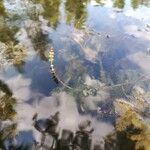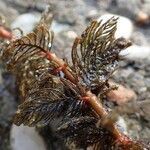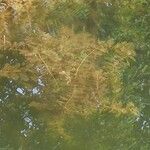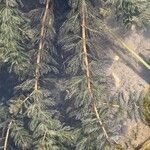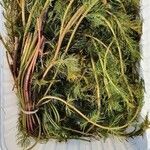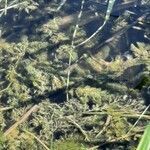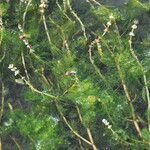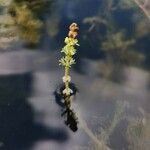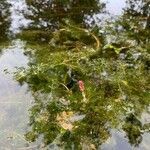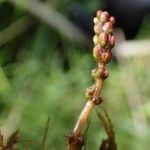Plants mostly monoecious, rarely with bisexual flowers. Stem much branched, 100-250 cm, densely leafy in upper part, sparsely light green warty; internodes ca. 3 cm. Submerged leaves 4-or 5-whorled, pectinate, broadly ovate in outline, 3-3.5 × 1-2.5 cm; segments in 13-16 pairs, filiform, 1-1.5 cm. Inflorescence a terminal spike of 4-whorled flowers, 6-10 cm; bracts reniform or suborbicular, shorter than flowers, broader than long. Male flowers: bracteoles rhombic to elongate, margin entire; calyx broadly campanulate, 0.5-1 mm, 4-parted nearly to middle; petals 4(or 5), pale pink, elliptic, 1.5-2.5 mm; stamens 8, without androphore. Female flowers: bracteoles pectinate, lanceolate in outline; calyx tubiform, 0.7-1 mm, margin shortly lobed; petals absent or minute and caducous. Fruit 4-loculed, subcylindric, ca. 2 × 1.5 mm; mericarps abaxially rounded, smooth or sparsely verrucose along margins. Fl. and fr. Apr-Sep.
Aquatic herb, usually submerged, occasionally creeping on to muddy banks; rhizome rooted; stems up to 2 m long, usually branched. Submerged leaves pinnatisect, in alternating whorls of (3)4(5), glabrous, ± equalling internodes; leaf-segments 7-11 on each side, filiform, usually obtuse at apex; stipule-like outgrowths absent or inconspicuous. Flowers unisexual or bisexual in terminal emergent spikes up to 10 cm long; spikes interrupted with whorls c. 1.5 cm apart along a 4-angled rhachis; whorls of 4 obovate entire bracts (except the lowest which are pinnatisect or dentate); upper bracts shorter than the flowers; bracteoles broadly ovate to triangular, entire. Petals 4, c. 3 mm long. Stamens (?2)8; anthers c. 2 mm long; filaments c. 2 mm long. Stigmas 4, spreading, papillose. Fruit subglobose, c. 3 mm in diameter, 4-sulcate, usually with 8 longitudinal verrucose ridges or rarely smooth.
A water plant which keeps growing from year to year. The stems can be simple or branched. They are up to 2 m long. The leaves are in rings of 3-4 leaves and are almost under the water. They are 1-3 cm long. They are divided into leaflets along the stalk and these leaflets are very narrow. There are 6-12 leaflets. The flowers is like a spike and emerges above the water. The flowers are separately male and female but on the same plant. The lower flowers in the spike are female and the upper ones are male. There are 4 petals about 2.5 mm long. Male flowers have 8 stamens.
Much like no. 9 [Myriophyllum sibiricum Kom.]; stem thickened below the infl to almost double its width farther down, curved to lie parallel with the water-surface, usually branching freely near the water-level; shoot-tip more tassel-like, with internodes mostly 1–3 cm; no turions; lvs with more numerous (mostly 12–20) long, straight segments per side; lower bracts often pectinate and often somewhat exceeding the frs; mericarps 2–3 mm; 2n=42. European sp., widely intr. in N. Amer., tolerant of nitrogenous pollution.
Perennial herb, hydrophyte, rooted, usually completely submerged except for leafless, flowering shoots; stems up to 3 m long. Roots few and small on lower parts of stem. Leaves arranged in whorls of 4-6, olive-green, finely divided. Flowers male or female, arranged in whorls on emergent spikes 50-100 mm long, cream-coloured. Flowering time Mar.-May. Fruit a small nut.
Flowers unisexual or bisexual in terminal emergent spikes up to 10 cm. long; spikes interrupted with whorls c. 1·5 cm. apart along a 4-angled rhachis; whorls of 4 obovate entire bracts (except the lowest which are pinnatisect or dentate); upper bracts shorter than the flowers; bracteoles broadly ovate to triangular, entire.
Submerged hydrophyte. Leaf segments finely divided, not glandular, apex not mucronulate, stipule-like outgrowths absent or inconspicuous. Flowers: in terminal emergent spikes, 50100 mm long; corolla cream-coloured; Mar.-May. Fruit a nut, ± 3 mm in diameter.
Submerged leaves pinnatisect, in alternating whorls of (3)4(5), glabrous, ± equalling intemodes; leaf-segments 7–11 on each side, filiform, usually obtuse at apex; stipule-like outgrowths absent or inconspicuous.
Monoecious or polygamous, rhizomatous, submerged, aquatic perennial to 2 m. Leaves whorled, feathery pinnatisect, lobes filiform. Flowers in terminal, emergent spikes, yellow.
Aquatic herb, usually submerged, occasionally creeping on to muddy banks; rhizome rooted; stems up to 2 m. long, usually branched.
Fruit subglobose, c. 3 mm. in diameter, 4-sulcate, usually with 8 longitudinal verrucose ridges or rarely smooth.
Stamens (?2)8; anthers c. 2 mm. long; filaments c. 2 mm. long.
Stigmas 4, spreading, papillose.
Petals 4, c. 3 mm. long.
